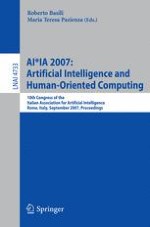2007 | Buch
AI*IA 2007: Artificial Intelligence and Human-Oriented Computing
10th Congress of the Italian Association for Artificial Intelligence, Rome, Italy, September 10-13, 2007. Proceedings
herausgegeben von: Roberto Basili, Maria Teresa Pazienza
Verlag: Springer Berlin Heidelberg
Buchreihe : Lecture Notes in Computer Science
